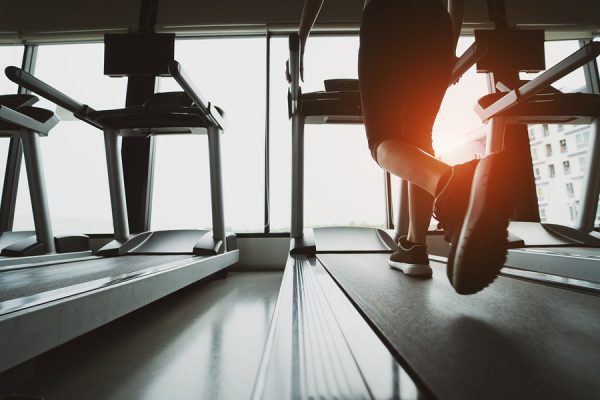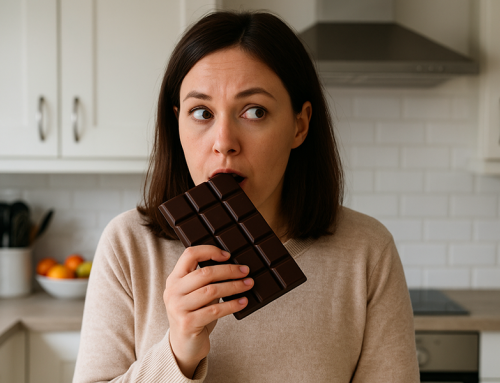Does fasted cardio burn more fat? 20 or 30 years ago, almost everyone in fitness and bodybuilding thought so. You can count me in that group. I was a 1990s and 2000s era competition bodybuilder and I did a lot of fasted cardio in the morning. Back then I also recommended it to my training clients for burning more fat. If you’re reading this Blog, maybe you even read the earliest (2003) edition of my classic book on burning fat (now updated), where I not only recommended cardio on an empty stomach for fat loss, but also, I said it I thought it was superior. That was then… 20 years ago…

This is now. 2023. Today, despite advances in exercise and weight loss science, many people still think fasted cardio burns more fat than fed cardio. If you still believe it, or if you’re a coach who still tells clients fasted cardio burns more fat, brace yourself… because… the truth is… the evidence says…
Fasted cardio does NOT burn more body fat than fed cardio.
Let’s be clear. The science isn’t saying that fasted cardio doesn’t work. We’re not saying there are no health benefits or advantages. We’re not ignoring how some people feel better exercising with no food sloshing around their stomach. We’re not suggesting cardio on an empty stomach doesn’t help with fat loss. Fasted cardio works for fat loss.
The specific question we’re addressing in this post is this: Does fasted cardio work better for fat loss than fed cardio? Does fasted cardio burn more body fat over time?
Today we know with a fair amount of confidence that the answer is no. Fasted cardio does not burn more body fat over time than fed cardio.
Here’s why it took so long to reach a verdict on fasted cardio. It’s because the right kind of research hadn’t been done in the 1990s and 2000s. All we had to go on was anecdotes and opinions. “Hey, it worked for me!” Or, it was just one of those fat loss myths that kept getting passed down for years (decades) without being questioned. Or, we were basing our beliefs on studies about fat oxidation, not body fat loss.
Fasted Cardio And Fat Oxidation
Here’s what I think is one of the main reasons so many people believe fasted cardio is better. Almost everyone is confused about the difference between fat oxidation during a workout and body fat loss over time. (Actual changes in body composition).
Studies going back decades have shown that fat oxidation increases while doing cardio fasted. This has been confirmed in more recent studies (Viera 2016, Liu 2023). Lots of people think that increased fat oxidation during a workout means more fat loss over time. It does seem logical that if cardio on an empty stomach makes you use more fat for fuel during the workout, then after a month or two, you should be leaner than if you did it fed.
But that’s not what happens. Remember, fat oxidation refers to what type of fuel you’re burning during your workout. Is it carbs or fat? Burning fat for fuel during a short workout isn’t the same thing as losing body fat over weeks and months.
What if you oxidize mostly fat for fuel during your morning cardio, but then pig out at dinner and finish the day at maintenance or even surplus calories?
Even if you stay in a deficit for the day, check this out: If you burn more fat for fuel during your workout, you may simply burn more carbs later in the day. If you burn more carbs during your workout, you may burn more fat later in the day. It’s a wash. That’s how your body works. (Paoli, 2011)
The absolute truth is, the amount of fat loss you get will depend on the size of the calorie deficit you sustain over time. It’s not about which fuel you use the most while training. So if your goal is fat loss, stop worrying about what fuel you’re burning during workouts. Instead, start focusing on sustaining a calorie deficit.
Here’s another way to look at it: A study might measure the amount of fat oxidized during a workout, but even if it finds that fasted training increases fat oxidation, that’s only 30 minutes or so out of the whole day. (And maybe only a few days a week). Most of your daily calorie burn happens in the other 23.5 hours, not during that short session in the gym.
Even if fat oxidation during cardio sessions does impact body fat loss, how much impact could it make? Low to moderate amounts of cardio don’t move the needle on fat loss that much. It takes fairly large amounts of cardio (combined with dietary control) to really put a dent in your fat stores.
And consider this. These studies on fat oxidation lasted for only a day, or even just hours. They didn’t even measure fat mass or body fat percentage at all, let alone after weeks or months of workouts. How could we know if fasted cardio increases fat loss if they didn’t even measure fat loss?
Is There Any Science Behind Fasted Cardio Increasing Body Fat Loss?
Physique athletes have recommended fasted cardio for at least 30 years. But it wasn’t until fairly recently that exercise scientists measured the effect it had on body composition (actual fat loss) over time.
One of the more notable studies was headed by Brad Schoenfeld. The purpose was to answer this question: Does cardio after an overnight fast maximize fat loss over time? The results were published in the Journal of the International Society of Sports Nutrition in 2014.
Twenty young female volunteers were randomly assigned to 1 of 2 groups. The first group did cardio after an overnight fast. The second group ate a meal before doing cardio. In both groups, they did 1 hour of steady-state aerobic exercise, 3 days a week for 4 weeks.
The subjects were given customized diet plans designed to create a calorie deficit. Food intake was tracked and nutrition counseling was offered to help with adherence.
Here were the fasted cardio results:
Both groups showed a significant loss of weight and fat mass, but there were no major differences between the groups. The subjects in both groups lost about the same amount of weight, regardless of whether they did cardio fed or fasted.
This was the first study on fasted cardio that measured body composition over a multi-week period, so we still need more research. However, these results confirm the current consensus that fasted cardio works, but it doesn’t work better than fed cardio.
Ideally, future studies will be longer, with larger sample sizes, including men and women of different ages. It would be interesting to include subjects with different body fat levels too. That’s because there’s some rationale to believe fasted cardio may benefit people who are already lean and down to their last pockets of stubborn fat.
Fasted Cardio And Stubborn Fat
When we say, “stubborn fat” we’re simply referring to the fact that some fat deposits are the last to come off. These spots often include the hips and thighs in women, and to a lesser degree, the belly fat and lower back fat in men. Where you store fat is is dictated partly by genetics and partly by the way hormones and receptors work in fat cells.
There are reasons some fat deposits are stubborn. To burn fatty acids, they first have to be released from the fat cell. What’s different about stubborn fat areas is they have higher concentrations of alpha-2 receptors. Without getting too deep into boring physiology, let’s just say that these adrenoreceptors put the brakes on fat breakdown from the cells (lipolysis). Differently stated, they keep fat locked inside certain fat cells.
Insulin can also inhibit fat release and these stubborn fat spots are highly sensitive to the effects of insulin. Eating carbs (and even protein) raises insulin. Therefore, scientists think that doing cardio fasted, when insulin is low, might allow more fat release from those stubborn areas.
This isn’t suggesting that spot reduction is taking place, nor that failing to get lean is because of insulin. If you have calorie a deficit, you’ll still lose fat. What we’re saying is that your body may pull the fat from some areas more easily than others. That leaves those pesky stubborn fat spots the last to go.
The practice of fasted cardio may have originally come from the bodybuilding world. Physique competitors are already lean, and some of these athletes believe that doing cardio fasted helps them get the last pockets of fat off, for that totally ripped look, with no visible fat at all, anywhere on the body.
There could be something to it. But then again, most dieters still have plenty of fat all over their bodies to draw on. And since they aren’t trying to get shredded, losing stubborn fat in specific spots isn’t even a conversation yet.
Possible Downsides Of Cardio On An Empty Stomach
While there might be a small added benefit in some circumstances, there are fasted cardio pros and cons to consider.
The newest study on fasted cardio (Liu 2023) found no negative side effects of fasted cardio. However, the population studied was young obese men who did only 30 minutes of brisk walking on the treadmill. We don’t know how older people, women or lean people might respond. This research also doesn’t tell us how people might respond to high intensity or long duration cardio fasted.
Anecdotally, some people report feeling less energy doing cardio on an empty stomach, especially when intensity is higher and duration is longer. That could reduce exercise performance, giving you less, not more fat loss. It’s also worth noting that individuals, even of the same demographic group may vary in their response. Some report low energy or even “bonking” completely when training fasted. Others say they feel fine, or even “great” doing cardio fasted. Ultimately you’ll have to try it and decide for yourself.
Another possible downside is that fasted cardio could increase the risk of losing muscle. If you’re lifting hard and eating enough protein, this is less of a concern, but should be on your radar. This is especially true when cardio volume is high and if your goal is going from already lean to ripped. Also, a 2015 study (Kim) suggested that theoretically fasted cardio could be more effective at reducing body fat in the short term. However, the authors warned that in their experiment, the fasted cardio group had higher cortisol levels after exercise than the fed group. They said that this might have a negative impact on long-term weight loss.
Your risk of muscle loss is lower when your body fat level is higher. Your risk of muscle loss is higher when your body fat is lower. That’s why, if you’re already low in body fat, you’ll want to keep an eye on your lean mass if you do a lot of cardio on an empty stomach.
The Final Word On Fasted Cardio
So what’s the bottom line? Fasted cardio vs fed cardio? Which one wins?
It’s still possible that fasted cardio may offer some slight advantage, including for lean people working on the last bits of body fat. If nothing else, many agree that doing early morning cardio is a great way to get your day started on the right foot. (And reduces the odds of blowing it off later when you’re exhausted after work and your willpower is lower).
I wouldn’t say the final word on fasted cardio is in yet. And in the 2023 study, research found a unique benefit – better insulin sensitivity, at least in people with obesity. But it’s safe to say the weight of the evidence today shows that fasted cardio does not improve body composition or increase body fat loss over time over compared to fed cardio. If we ever discover that it does, I’ll bet that it’s a small effect, not a big needle mover.
You can lose fat doing cardio fasted and you can lose fat doing it fed. But either way, the amount of fat you lose will probably be about the same.
Based on what we know now, here’s the message fat loss seekers need to hear and fat loss coaches need to share:
Deciding when and how to do cardio should be based primarily on personal preference. If you like doing it in the morning before breakfast, do it. If you like doing it after breakfast, do it. If you like doing it some other time of day after you have some meals in you, do it. If you want to do it at night, do it. There won’t be much difference in fat loss either way.
In addition, the best way to do cardio is the way that gives you the most energy and highest performance during the workout. The best time is also whenever you’ll do it the most consistently. Adherence is everything.
Train hard and expect success!
Tom Venuto,
Author, Burn the Fat Guide to Flexible Meal Planning For Fat Loss
Founder, Burn the Fat Inner Circle
PS. Need help with fat loss? Hit a fat loss plateau? Did you know that macro-based meal planning is the indisputable best way to break a fat loss plateau? And did you know that you can create your own do it yourself meal plan? (Without paying expensive coaches who only give you generic meal plans anyway). It’s true. Learn more at the Burn the Fat website here.

Tom Venuto has been a trusted natural bodybuilding and fat loss expert since 1989. He is also a recipe creator specializing in fat-burning, muscle-building cooking. Tom is a former competitive bodybuilder and today works as a full-time fitness coach, writer, blogger, and author. In his spare time, he is an avid outdoor enthusiast and backpacker. His book, Burn The Fat, Feed The Muscle is an international bestseller, first as an ebook and now as a hardcover and audiobook. The Body Fat Solution, Tom’s book about emotional eating and long-term weight maintenance, was an Oprah Magazine and Men’s Fitness Magazine pick. Tom is also the founder of Burn The Fat Inner Circle – a fitness support community with over 53,000 members worldwide since 2006. Click here for membership details
Scientific References:
Hackett, D et al, Effect of Overnight Fasted Exercise on Weight Loss and Body Composition: A Systematic Review and Meta-Analysis, Journal of functional morphology and kinesiology, 2:4, 2017.
Kim TW et al, Comparison of the effects of acute exercise after overnight fasting and breakfast on energy substrate and hormone levels in obese men, Journal of Physical Therapy Science, 27:6, 1929-1932.
Liu X, et al, The Effects of Six Weeks of Fasted Aerobic Exercise on Body Shape and Blood Biochemical Index in Overweight and Obese Young Adult Males, Journal of Exercise Science and Fitness, 2023.
Paoli A, et al, Exercising fasting or fed to enhance fat loss? Influence of food intake on respiratory ratio and excess postexercise oxygen consumption after a bout of endurance training, nt J Sport Nutr Exerc Metab, 21(1):48-54, 2011.
Schoenfeld B, Body composition changes associated with fasted versus non-fasted aerobic exercise. Journal of the International Society of Sports Nutrition. 11:54. 2014
Viera A et al, Effects of aerobic exercise performed in fasted v. fed state on fat and carbohydrate metabolism in adults: a systematic review and meta-analysis, 116:7, 2016.







I often fear that we lose sight of the big picture, the macroeconomics of exercise, if you will. If the driving predictor of outcome is energy balance, then what matters is establishing a deficit that can be sustained emotionally and physically without compromising health. To that end, the role of recovery (physical and mental) must be considered.
These issues arise in the the context of this discussion because I have always believed that working steadily for long periods of time to build up endurance pays off. If I can develop the ability to increase my work without incurring a long recovery debt, I can do that work more often. I can eat more, which improves nutrition.
So, when topics of “what is best” comes up, my first thought is, how does it affect the ability to develop steady state endurance exercise, simply for the sake of jacking up calories burned while reducing recovery. In the current context, I’d want to know whether fasted cardio increases endurance exercise ability in the sense of higher energy capacity with less recovery, which I think means staying aerobic….which means fat metabolism.
This isn’t meant to disagree, but to raise the “macroeconomics” perspective for sake of discussion.
Hi Ed, thanks for posting. youre right the driving predictor of *weight loss* outcome is energy balance. Youre also right about context. The context of this post is purely fat loss. The “is fasted cardio better for fat loss” debate has been around for 30+ years. surprising its still debated given current evidence, yet not surprising since the evidenced based community, while growing, is still small. Laypersons in 2023 still follow advice dished out in 1993 or just believe anything the masses currently believe. But outside of fat loss and getting into endurance, indeed this is an interesting area. Mike McKnight ran 118 miles completely fasted … im still scratching my head… but his training and dietary experiments had nothing to do with fat loss, right? He was chasing performance and testing what kind of fueling was needed (or not needed). guy has no fat, lol. totally different context. take your average overweight dude… if he does cardio fasted will he lose more body fat over time than if he did it fed? evidence says no. Cheers.
Burning fat can be tricky, I usually always go to the gym and work out on a empty stomach, but I might have protein shake sometimes, but it works great for me. Great Article Ed, Eating healthy is a good start to obtain great health benefits. Taking one day at a time is very essential to a healthy life style and weight loss. I had a good weight loss journey which maintained doing different fasts over a few months, and loss like 35lbs. but also depends on what fits you. Take it one day at a time.